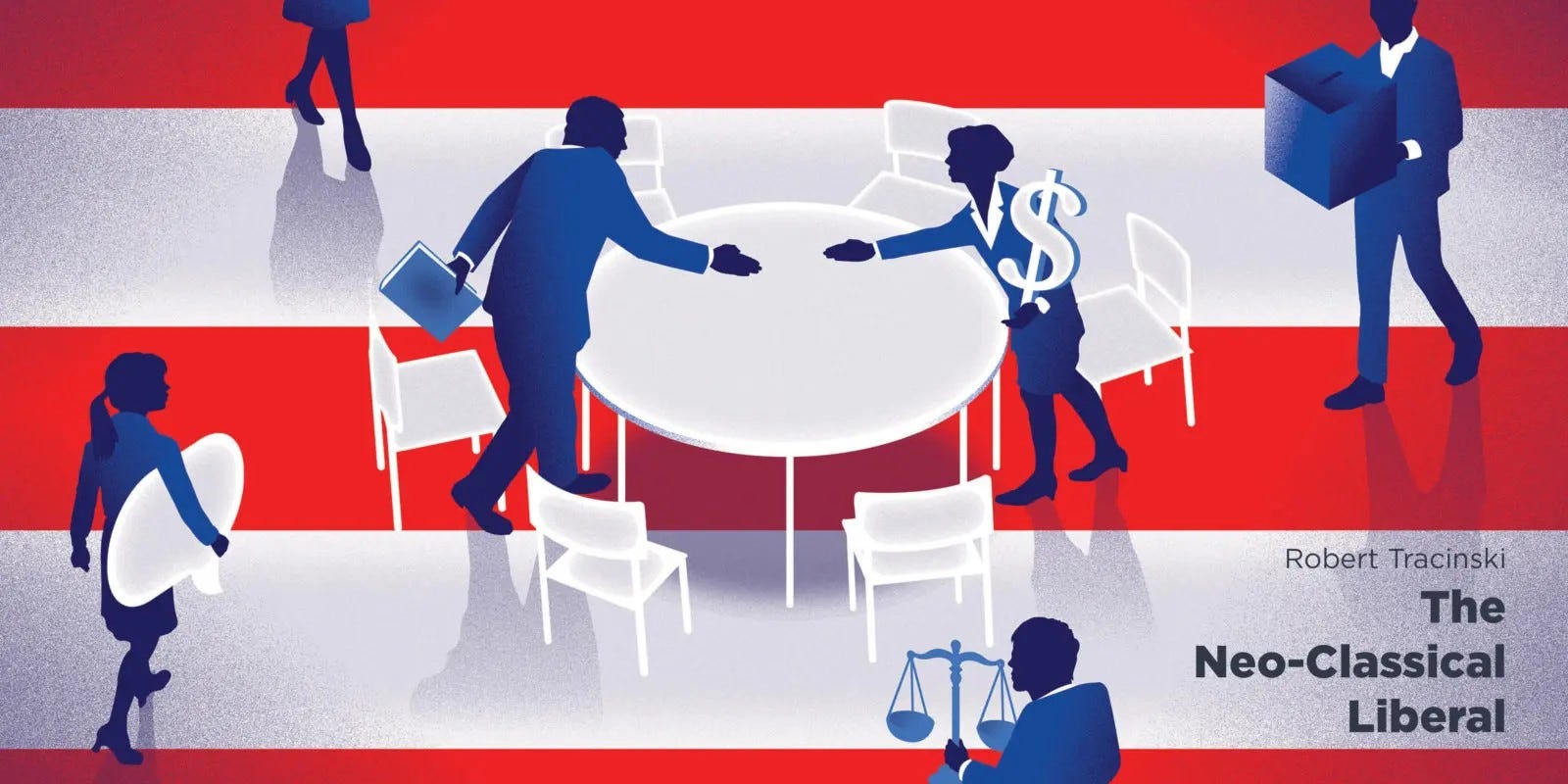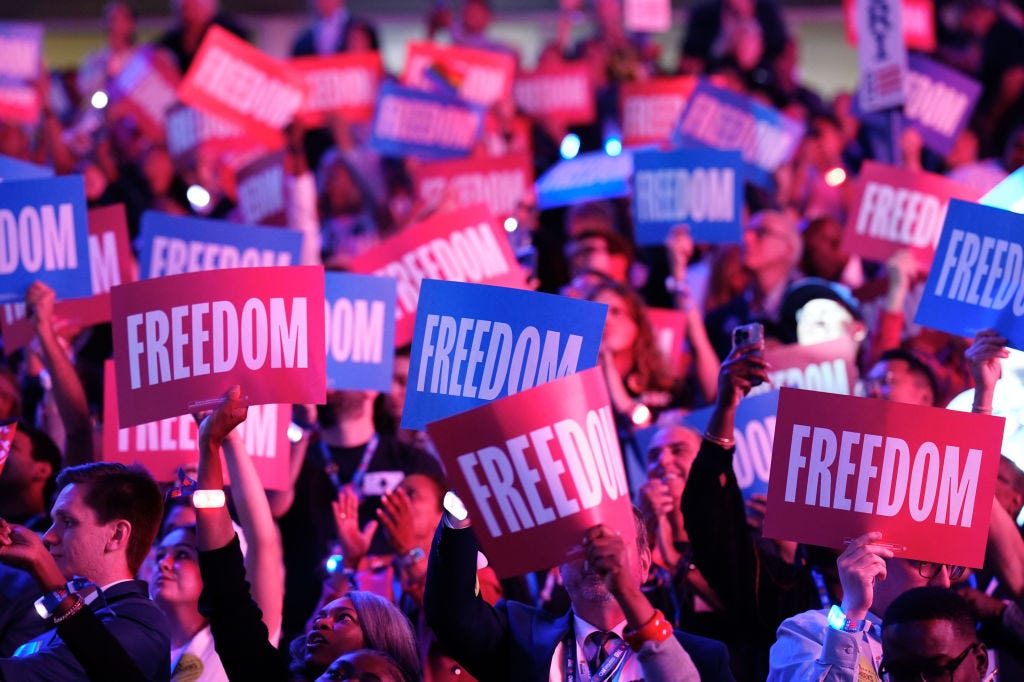|
 |
The Democrats, as improbable as it may seem to some of us, are trying to steal the issue of “freedom” and claim it for themselves. Here is how a Washington Post report describes Kamala Harris’ entry at last month’s Democratic National Convention:
Harris on Monday took the stage for a surprise appearance to the rousing beat of Beyoncé’s “Freedom,” her campaign’s unofficial anthem. She was preceded onstage by a nearly three-minute hype video set to the same song, with the narrator promising “freedom from control, freedom from extremism and fear.” Together, the night’s speakers referenced “freedom” more than 100 times. And on Wednesday, the convention’s entire program will be dedicated to the theme “A Fight for Our Freedoms.”
“Freedom” is literally the campaign’s “Message Imperative #1.”
Consider the Sept. 10 presidential debate. Amid the widespread discussion of Donald Trump’s disastrously undisciplined performance, it was easy to miss something more substantive. A search through the transcript of the debate reveals that Harris used the word “freedom” four times, most of them in these two passages. “I think the American people believe that certain freedoms, in particular the freedom to make decisions about one’s own body, should not be made by the government.” And: “I will be a president that will protect our fundamental rights and freedoms, including the right of a woman to make decisions about her own body and not have her government tell her what to do.”
How many times did Trump use “freedom”? Zero—and this is typical of his speeches. It’s a shocking reversal from the past 50 years, when Republicans from Ronald Reagan through the Tea Party movement practically trademarked the word.
Why are the Democrats doing this, and what are the limits of this new “freedom” campaign?
Mind Your Own Business
The “freedom” theme was previewed on the campaign trail by Harris’ vice presidential nominee, Minnesota Gov. Tim Walz, who offered up his own manifesto of old-fashioned cultural liberalism:
Some of us in here are old enough to remember when it was Republicans who were talking about freedom. It turns out now what they meant was the government should be free to invade your doctor's office. In Minnesota we respect our neighbors and their personal choices that they make. Even if we wouldn’t make the same choice for ourselves, there’s a golden rule: Mind your own damn business.
Walz continued the theme in his acceptance speech at the convention, which clarified the limits of this concept of freedom:
[T]his is a big part about what this election is about. Freedom. When Republicans use the word freedom, they mean that the government should be free to invade your doctor’s office. Corporations—free to pollute your air and water. And banks—free to take advantage of customers.
But when we Democrats talk about freedom, we mean the freedom to make a better life for yourself and the people that you love. Freedom to make your own health care decisions. And yeah, your kids’ freedom to go to school without worrying about being shot dead in the hall.
He also invoked “the future that we’re building together, in which everyone is free to build the kind of life they want,” and “no matter who you are, Kamala Harris is going to stand up and fight for your freedom to live the life that you want to lead.” It’s Message Imperative #1.
From Woke to Free
In one important respect, this is a welcome shift. The past 10 years have been the era of wokeness and anti-wokeness. “Wokeness” is notoriously ill-defined, but we all know what the fuss was about. In the late 2010s, clusters of the online left stepped up their effort to search out and destroy anything that might be ideologically “problematic”; see one young woman’s confession in The New York Times about her own online vendetta campaign.
They could target you for saying the wrong thing or even for wearing the wrong shirt. Television shows were turned into “after-school specials”—as one influential complaint about “The Great Awokening” put it—that were more dedicated to drumming in the correct political and cultural message than to providing entertainment. Writers, academics and artists were “canceled,” even the ones who were already dead.
This initiative never came top-down from top Democratic politicians, mind you. It was enforced bottom-up by overzealous volunteers. But it associated the entire American left with a secularized Church Lady attitude that was eager to rap us on the knuckles at any sign of disobedience. It made the Democratic Party synonymous with conformity rather than freedom. Conservatives sensed this and reorganized their whole movement around the culture war and a notoriously vague concept of anti-wokeness.
The Democratic Party is now attempting to shake off this association by positioning itself as the party of freedom that will respect your personal choices “even if we wouldn’t make the same choice for ourselves.”
The Four Freedoms and the Two Freedoms
This message about freedom is not really new. Democrats are attempting a return to old-fashioned 20th-century left-liberalism. It’s the liberalism that will defend your freedom “to live the life you want to lead”—in those areas that pertain to your personal life, your lifestyle and especially your sex life. You will be free to read the books you like, to have a relationship with someone of the same sex, to get an abortion.
The problem is that their passion for freedom is limited to those issues. In your economic life, you’re going to be told what to do an awful lot, particularly in those areas where you are a producer of goods and services—which most of us are, in our working lives—rather than a consumer.
Consider one of Vice President Harris’ main economic proposals: a ban on “price-gouging” for common goods like groceries. What does “price gouging” even mean? An existing proposal sponsored by Massachusetts Sen. Elizabeth Warren declares that a “person shall be presumed to be in violation [if] … [he] sells or offers for sale a good or service at an excessive price compared to … the average price at which the good or service was sold or offered for sale … during the 120-day period preceding [an] exceptional market shock.”
Readers of Ayn Rand’s “Atlas Shrugged” will find this reminiscent of the language of Directive 10-289, the fictional decree imposing economic dictatorship, in its use of a vaguely defined “emergency” to limit prices and all other economic activity to the static level of a “base year.” That too is a part of the old left-liberal creed, which Rand memorably lampooned as the view of man as “a soul freewheeling to the farthest reaches of the universe—but wearing chains from nose to toes when he crosses the street to buy a loaf of bread.” Quite literally to buy a loaf of bread, if it is deemed to be “price-gouging.”
You can see this combination more clearly in one of Walz’s final lines from his convention address. “That’s how we’ll build a country where workers come first, health care and housing are human rights, and the government stays the hell out of your bedroom.” Housing can be a “right” only by violating the rights of those who pay for housing—and government might stay out of our bedrooms but definitely won’t stay out of our wallets.
This left-liberal tradition was most famously stated in Franklin Roosevelt’s Four Freedoms speech: freedom of speech, freedom of worship, freedom from fear, and freedom from want. The first three are classical-liberal “negative” freedoms, the freedom to be shielded from coercion. (Freedom from fear, as Roosevelt used it in 1941, referred to freedom from Nazi aggression.) Freedom from want, however, is a so-called “positive” freedom, the right to be provided with goods by the government. Roosevelt listed among those goods jobs and health care, to which left-liberals later added housing, a college education and everything but the kitchen sink—the whole edifice of the modern welfare and regulatory state. But this implies the loss of someone else’s negative freedom because they will have to be taxed or mandated to provide us with these goods.
The Four Freedoms approach has the actual effect of creating two freedoms—one that is protected and one that is not. Freedom of speech and freedom in one’s personal life is to be protected as an absolute. But economic freedom, freedom in one’s working life, the ability to succeed and prosper—all of this is significantly curtailed.
The Dropped Banner of Freedom
The conservatives have their own version of the two freedoms, but with the sides switched.
An interesting profile in “Mother Jones” describes how Democrats adopted freedom as their central message in response to the Heritage Foundation’s Project 2025, a conservative wish list for the next administration, which includes proposals for conservative intrusion on personal freedom, including stricter limits on abortion and birth control, a ban on pornography, and a government policy to “maintain a biblically based … definition of marriage and family.”
Conservatives tend to be more sympathetic to economic freedom—though increasingly less so under the influence of nationalist conservatives—but they definitely want to crack down on all that wokeness in your personal life. This, too, has a long history. In the same line where she described the 20th-century liberals’ split view of freedom, Rand went on to criticize the conservatives, who “see man as a body freely roaming the earth, building sand piles or factories—with an electronic computer inside his skull, controlled from Washington.” Hence all the book banning, the attempts to mandate one-sided “patriotic history,” or teaching the Bible in public schools and various forms of supposedly “pro-family” social engineering, which ends up spilling over into economic controls.
Consider conservatives’ criticisms of the Harris campaign’s freedom message, which usually end up lamenting that it doesn’t include the freedom to, erm, ban transgender athletes. There is a whole debate to be had about this issue, but it’s a debate over the culture war rather than over the issue of freedom. Today’s conservative movement is almost entirely focused on seizing the power to suppress the people they view as cultural enemies. They have spent so long defining themselves as anti-woke that they have forgotten how to be pro-freedom.
If the Democrats are now taking up the banner of freedom, it is because conservatives dropped it. But Democrats are advocating freedom in the way they find comfortable: limiting freedom to specific realms and denying it in others.
The One Freedom
In that “Mother Jones” profile, there is one revealing passage in which an activist describes how the campaign switched themes from democracy to freedom because they found the message of freedom to be more inspiring: “The conversation around freedom, the conversation around our futures, is something that I welcome because it does give people something to fight for rather than against.”
Perhaps that is something we can learn from because freedom is truly an inspiring message, and a positive one. But the two freedoms, personal freedom and economic freedom, are really just different aspects of one freedom: our freedom to make decisions about our own lives and futures. To have one party advocating one aspect of this freedom is better than having no party advocating either, which is where we’ve been heading in the last decade. But we still need a political movement that will champion all freedoms, that will champion the one freedom.
All we have to do is to truly embrace the “golden rule” named for us by Gov. Walz: “Mind your own damn business.”
You’re currently a free subscriber to Discourse .


